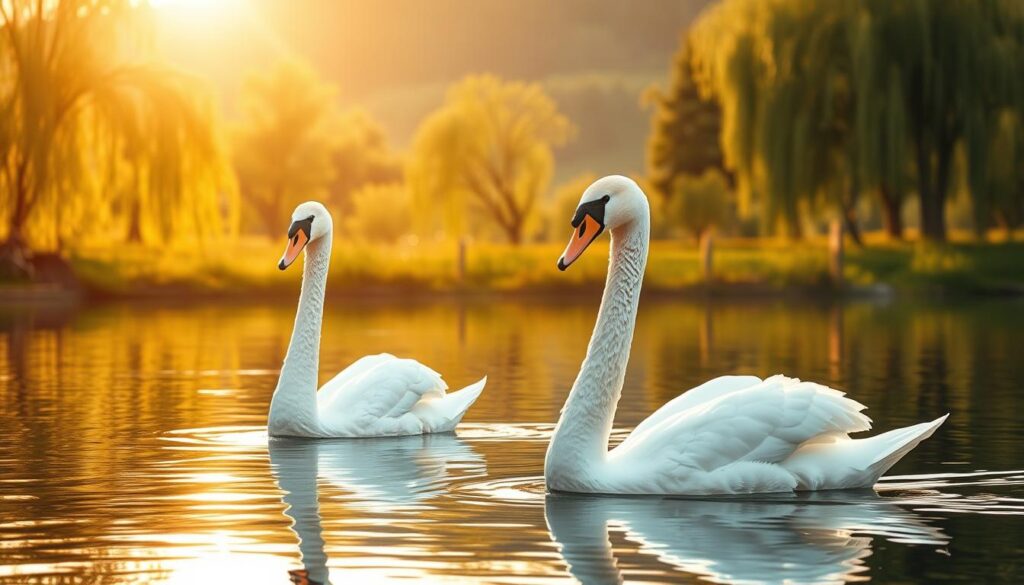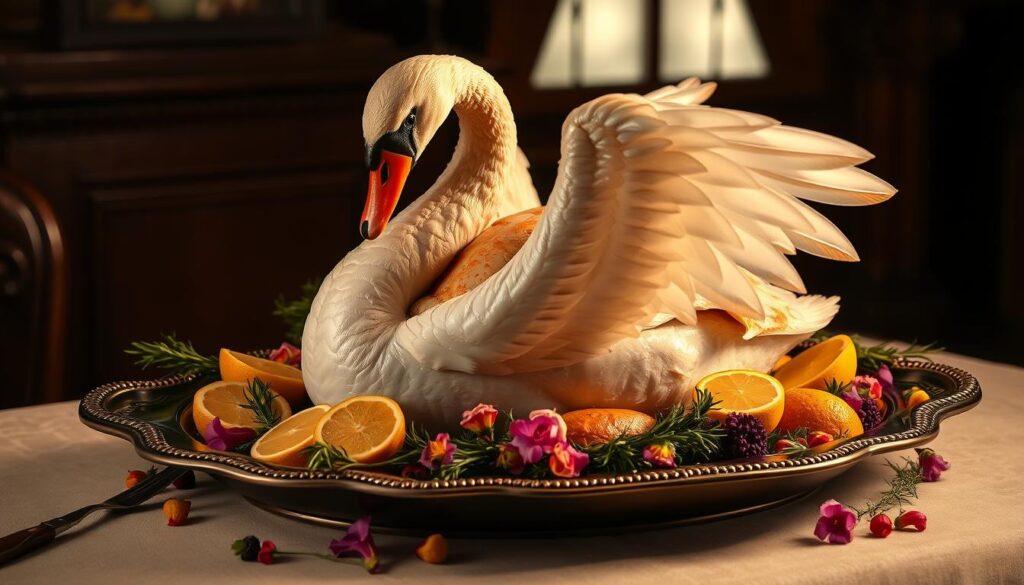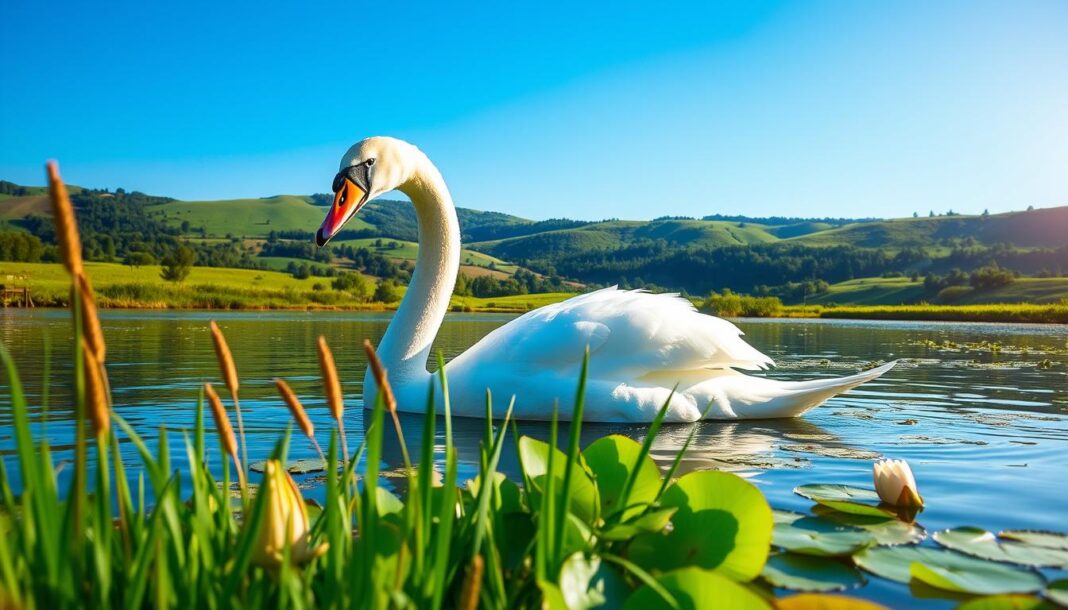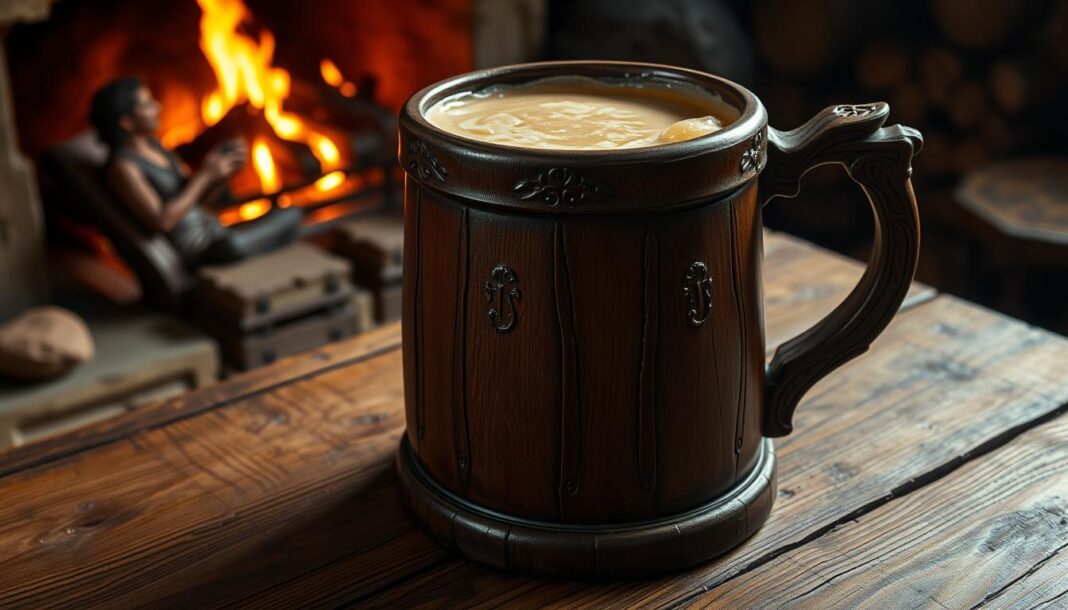In medieval and Renaissance Europe, swans were a prestigious dish reserved for royalty and nobility. Unlike in some parts of Europe, in England, duck was not a staple for everyday consumption; instead, it was served at feasts and special occasions. Swans, domesticated for centuries, were considered a delicacy, with the young birds being preferred for their tender meat.
The practice of eating swan involved raising the young birds on barley to fatten them up, making them a prized food item. As noted in historical accounts, such as those found on food historical jottings, swans were an item of commerce and were sold in markets. Although eating swans is not common today, understanding this historical practice provides valuable insight into past culinary customs.
Key Takeaways
- The historical significance of swans as a culinary delicacy in medieval Europe.
- The practice of domesticating and raising swans for food.
- The evolution of swan preparation and its presentation.
- The role of swans in royal and noble cuisine.
- The current status of swan consumption and its historical context.
The Royal Bird: Swan’s Place in Historical Cuisine
The swan, a majestic bird with a rich history, has been a coveted delicacy and symbol of power throughout the centuries. In historical cuisine, swans were not only a feast for the eyes but also a reflection of the host’s status and prestige.
Symbol of Status and Prestige
Swans have long been associated with luxury and nobility, making them a prized ingredient in medieval and Renaissance cuisine. In fact, serving swan at a banquet was a statement of wealth and power, as these birds were difficult to obtain and prepare. The practice of serving swan at special occasions continues to this day, albeit in a more symbolic manner, highlighting their enduring significance in culinary culture.

- The tradition of consuming swan reflects the bird’s symbolic importance in historical contexts, often representing love, fidelity, and nobility.
- The swan’s place in life during medieval times was closely tied to its role in the cuisine of the nobility, reinforcing social hierarchies.
Royal Ownership and Legal Protection
The legal history of swan ownership in England is a fascinating tale of royal privilege and strict regulation. Since the 12th century, all swans in England have officially belonged to the monarch, making unauthorized swan hunting a serious crime. Today, this legacy continues in the form of “swan-upping,” an annual census that underscores the ongoing importance of royal swan ownership.
The marking of swans to denote ownership has evolved significantly over time, from carving notches into their beaks to the modern practice of ringing them. Any un-ringed swan is automatically assumed to belong to the Crown, highlighting the place of swans within the legal framework of historical England.
Preparing Roast Swan: A Historical Recipe
In the world of historical foods, roasting a swan stands out as a dish fit for royalty. This majestic bird, with its snowy plumage and stately demeanor, was a centerpiece of grand feasts throughout history. Preparing a roast swan involves a series of elaborate steps, from the initial preparation to the final presentation.
Selecting and Preparing Your Swan
The first step in preparing a roast swan is selecting the right bird. Historically, swans were chosen for their size and the condition of their feathers. Once selected, the swan needed to be prepared for roasting. This involved carefully removing the skin with its feathers intact, a process that required great care to avoid damaging the plumage. The swan was then split between the shoulders and cut along the stomach, a step that facilitated the removal of the innards while keeping the skin and feathers undamaged.
The Traditional Roasting Method
With the swan prepared, the next step was to roast it. The bird was put on a spit, skewered to ensure even cooking, and then gilded to add a luxurious touch. The roasting process was a critical step, requiring constant attention to ensure that the swan was cooked to perfection. For those interested in other historical roasting techniques, our exploration of Game of Thrones-inspired foods offers insights into the broader context of historical cuisine.
The Art of Re-dressing in Plumage
Once cooked, the swan was re-dressed in its original plumage. This involved carefully replacing the skin with feathers over the cooked bird, ensuring that the neck was positioned “nice and straight or flat” to create a lifelike appearance. The feet were often preserved or reattached to complete the illusion, making the dish a spectacular centerpiece for any banquet. The final touches might include gilding the feathers with gold leaf, adding to the dish’s opulence.

Roast Swan Recipe from Medieval Texts
In the medieval kitchen, preparing roast swan was an elaborate affair, involving specific steps and ingredients. To recreate this historical dish, we must understand the traditional methods and ingredients used. The process was not just about cooking a bird; it was about presenting a spectacle that showcased the host’s wealth and status.
Ingredients and Equipment
To prepare roast swan, one would have needed a plump swan, fresh or well-hung to enhance the flavor. The ingredients would have included salt, pepper, and various herbs such as thyme and rosemary. For equipment, a large roasting spit or a substantial oven was necessary, along with a roasting pan and utensils for basting. The swan would have been trussed to ensure even cooking, with its legs tied and wings secured against the body.
The traditional roasting method involved slow cooking over an open fire or in a wood-fired oven, which imparted a rich, smoky flavor to the bird. The cooking juices were crucial, often used to make a gravy or to soak bread, a common practice for serving with game birds.
Preparation Steps
The preparation of roast swan began with cleaning and preparing the bird for roasting. This involved seasoning the cavity with salt, pepper, and herbs, then trussing the swan to promote even cooking. The swan was then roasted, either on a spit or in an oven, with regular basting to keep the meat moist and enhance the flavor. The roasting process was slow, taking several hours to achieve tender, fall-off-the-bone meat.
Once cooked, the swan was often ‘re-dressed’ in its plumage to create a dramatic presentation on the table. This practice, common for impressive game birds, made the dish a centerpiece for formal banquets and feasts.
Serving Suggestions and Accompaniments
Roast swan was typically served as the main course of a formal dinner, accompanied by various side dishes. Bread soaked in the cooking juices was a common accompaniment, enhancing the flavor of the meal. Other dishes might include roasted vegetables, savory pies, or elaborate sauces, all contributing to a rich and satisfying meal.
The presentation was often enhanced with decorative elements, such as gilded feathers or elaborate garnishes, emphasizing the swan’s status as a luxury food item. The ceremonial carving and serving of the swan added to its prestige, following specific historical dining etiquette protocols.
| Ingredient | Quantity | Preparation |
|---|---|---|
| Swan | 1 | Cleaned and trussed |
| Salt | To taste | Rubbed inside and out |
| Pepper | To taste | Rubbed inside and out |
| Herbs (Thyme, Rosemary) | Fresh, chopped | Stuffed inside the cavity |
Swan Consumption Through the Ages: From Royal Tables to Modern Curiosity
From royal banquets to modern curiosity, the history of eating swan is a complex tale of culinary privilege and cultural evolution. Historically, swans were reserved for the tables of royalty and high nobility, symbolizing status and prestige.
The consumption of swans was strictly tied to social class, with the upper classes enjoying a diverse diet that included various birds and game. In contrast, common people ate simpler fare such as bread, porridge, and occasional meat. The practice of hunting birds for the table was widespread among the nobility, considering anything with feathers as ‘fair game’.
As culinary tastes changed and legal protections increased, the appeal of swan meat gradually declined. Today, while some institutions like the British royal family and fellows of St. John’s College, Cambridge, still retain the right to consume swan meat, it is largely a relic of the past. The journey of swan from a prestigious centerpiece to a protected species reflects broader changes in our relationship with food and wildlife conservation.
This historical context provides a fascinating glimpse into the evolution of dining as both sustenance and social signifier, highlighting the complex dynamics between culinary practices, social hierarchy, and conservation.


